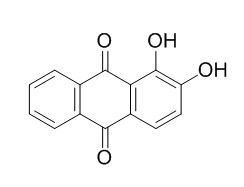Alizarin
Alizarin has a selective and effective inhibitory activity towards cancerous cells, it acts through the inhibition of ERK phosphorylation and cell cycle arrest in the S-phase. Alizarin has antigenotoxic activity, which can be explained by inhibition of CYP activities responsible for activating the mutagens.
Inquire / Order:
manager@chemfaces.com
Technical Inquiries:
service@chemfaces.com
Tel:
+86-27-84237783
Fax:
+86-27-84254680
Address:
1 Building, No. 83, CheCheng Rd., Wuhan Economic and Technological Development Zone, Wuhan, Hubei 430056, PRC
Providing storage is as stated on the product vial and the vial is kept tightly sealed, the product can be stored for up to
24 months(2-8C).
Wherever possible, you should prepare and use solutions on the same day. However, if you need to make up stock solutions in advance, we recommend that you store the solution as aliquots in tightly sealed vials at -20C. Generally, these will be useable for up to two weeks. Before use, and prior to opening the vial we recommend that you allow your product to equilibrate to room temperature for at least 1 hour.
Need more advice on solubility, usage and handling? Please email to: service@chemfaces.com
The packaging of the product may have turned upside down during transportation, resulting in the natural compounds adhering to the neck or cap of the vial. take the vial out of its packaging and gently shake to let the compounds fall to the bottom of the vial. for liquid products, centrifuge at 200-500 RPM to gather the liquid at the bottom of the vial. try to avoid loss or contamination during handling.
BMC Plant Biol.2023, 23(1):239.
Molecules2021, 26(1),230
Institute of Food Science & Technology2021, 45(9).
Metabolites.2023, 13(6):689.
J Agric Food Chem.2024, 72(42):23183-23195
Molecules.2018, 23(9):E2121
Chem Res Toxicol.2023, 36(2):213-229.
Front Pharmacol.2021, 12:765521.
Onco Targets Ther.2017, 10:3467-3474
Integr Med Res.2024, 13(1):101025.
Related and Featured Products
J Orthop Res. 2012 Sep;30(9):1486-92.
The natural compound Alizarin as an osteotropic drug for the treatment of bone tumors.[Pubmed:
22411621]
Despite significant clinical improvements, conventional therapies for bone cancer treatment are limited by significant systemic toxicity and lack of specific targeting. In this study, we considered Alizarin, a natural hydroxyanthraquinone derived from madder root with high affinity to calcium and remarkable osteotropic features, as a novel approach for bone cancer treatment. Due to its antitumor properties, as demostrated in colon cancer cells, and to its tropism to bone, Alizarin may be an ideal drug to reduce bone tumor growth.
METHODS AND RESULTS:
We demonstrated that low dosages of Alizarin strongly inhibited the osteosarcoma (IC(50) for Saos-2, MG-63, and U-2 OS cells, 27.5, 29.0, and 69.9 µg/ml, respectively) and breast carcinoma (IC(50) for MDA-MB-231 cells, 62.1 µg/ml) cell proliferation in vitro. Importantly, Alizarin had a significantly lower inhibitory activity on normal cells (IC(50) for MSC, 828.6 µg/ml), thereby revealing a selective activity towards malignant cells. Furthermore, we found that Alizarin acted through the inhibition of ERK phosphorylation and cell cycle arrest in the S-phase. Finally, Alizarin significantly and strongly impaired both osteosarcoma and breast cancer tumorigenesis.
CONCLUSIONS:
Our results highlight a selective and effective inhibitory activity of Alizarin towards cancerous cells, laying the basis for further studies to investigate its application in bone cancer therapy.
J Phys Chem B . 2017 Apr 27;121(16):4129-4136.
Ultrafast Intramolecular Proton Transfer of Alizarin Investigated by Femtosecond Stimulated Raman Spectroscopy[Pubmed:
28375609]
Abstract
We report time-resolved stimulated Raman spectra of Alizarin in DMSO solution with 403 nm excitation. Upon photoexcitation, the intramolecular proton transfer reaction of Alizarin occurs in 70-80 fs, which is confirmed by both the population growth and the frequency and bandwidth changes of skeletal vibrational modes of Alizarin. Interestingly, the vibrational frequencies of ν(C═C) and ν(C═O) show opposite shifts during the reaction, which may implicate changes in the resonance structure of anthraquinone and the attached carbonyl group. Vibrational relaxation in the potential surface of the proton transferred tautomer of Alizarin and the population decay occurring with two distinct time scales were also observed in addition to the solvation dynamics of DMSO solvent molecules.
Mutat Res. 2002 Oct 31;508(1-2):147-56.
Inhibition of human cytochrome P450 1B1, 1A1 and 1A2 by antigenotoxic compounds, purpurin and alizarin.[Pubmed:
12379470]
Recently we have shown that anthraquinone food pigments such as purpurin and Alizarin suppress the genotoxic activities of several mutagens including heterocyclic amines and polycyclic aromatic hydrocarbons in the Drosophila DNA repair test and in the Ames test.
METHODS AND RESULTS:
To investigate the mechanism of this inhibition, we have now examined the effects of these anthraquinone pigments on enzymes that metabolize xenobiotics. The activities of eight human recombinant cytochrome P450 (CYP) isozymes were measured in the presence of purpurin, Alizarin or carminic acid. Purpurin and Alizarin strongly inhibited the activities of CYP1A1, CYP1A2 and CYP1B1, and weakly suppressed those of CYP2A6 and CYP2E1 in a dose-dependent manner, but did not inhibit those of CYP2C19, CYP3A4 and CYP3A5. Carminic acid did not affect the activities of any CYPs tested. CYP1B1 was the most strongly affected CYP molecule by purpurin and Alizarin among CYPs examined in this study. From kinetic analysis, it was shown that the inhibition by purpurin on CYP1B1 was both competitive and non-competitive, and that by Alizarin was competitive. The values of slopes obtained from Lineweaver-Burk plots are proportional to the square of purpurin concentration. This observation suggests that two molecules of purpurin are interacting with one molecule of CYP1B1. The K(m) value of CYP1B1 was 11 microM, and the K(i) value of purpurin and Alizarin against CYP1B1 was 0.7 microM(2) and 0.5 microM, respectively. We also examined the effects of these pigments on the mutagenicities of MeIQx and B[a]P in the Ames test, using Salmonella typhimurium TA1538 co-expressing each form of human CYP and NADPH-cytochrome P450 reductase (OR). The mutagenicity of MeIQx in TA1538 1A2/OR or 1B1/OR was suppressed by purpurin and Alizarin but not by carminic acid. Purpurin also reduced the mutagenicity of B[a]P in TA1538 1A1/OR or 1B1/OR.
CONCLUSIONS:
These results suggest that the antigenotoxic activities of purpurin and Alizarin can be explained by inhibition of CYP activities responsible for activating the mutagens.



